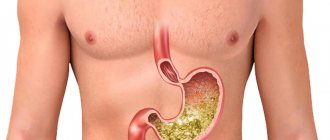Flatulence (from the Greek word meaning rising, bloating) is an excessive formation, accumulation of gases in the lumen of the digestive tract. A healthy person's gastrointestinal tract contains about 200 ml of gases. The gases include a mixture of hydrogen, methane, nitrogen, sulfur, and carbon monoxide.
Bloating is a common and unpleasant symptom that sometimes causes a person to suffer more than abdominal pain. Bloating is a subjective sensation of excess gas in the gastrointestinal tract; it is included in the medical concept of flatulence syndrome.
Causes of flatulence
Aerophagia
Normally, when eating food and liquid, or swallowing saliva, a small amount of air enters the stomach. But often there is increased swallowing and swallowing more air:
- when eating in a hurry (fast food),
- when talking while eating,
- smoking,
- drinking carbonated drinks,
- drinking through a straw,
- using chewing gum
- with poorly fitting dentures,
- some mental states (anxiety, hysterical psychoses).
Lack of enzymes in the gastrointestinal tract
The lack of enzymes leads to the fact that a large amount of undigested food debris ends up in the lower parts of the digestive tract. The processes of rotting and fermentation are activated there. During fermentation processes, sudden gas formation , bloating, rumbling, transfusion, and increased release of gases (carbon dioxide and methane) are observed. This is most often observed after eating plant foods, milk, and rye bread.
Putrefactive processes ( dyspepsia ) develop with excessive consumption of food proteins due to enhanced enzymatic digestion of them. Flatulence is less pronounced, but the gases released are more smelly due to hydrogen sulfide and ammonia.
In the formation of carbon dioxide, the level of hydrochloric acid in the stomach and the activity of pancreatic secretions, enzymatic deficiency (intolerance to lactose, fructose, wheat) are important.
A larger amount of gases is represented by intestinal gases (up to 75%). They are formed during the enzymatic activity of intestinal bacteria during the digestion of food components.
In the small intestine, small gas bubbles mix with food. Only 20% of gases are of bacterial origin.
In the colon, gases are 100% formed by bacteria, and due to the high density of the contents in the intestine, the processes of penetration of gases into the blood are disrupted. This creates conditions for the accumulation of large amounts of gases.
A healthy person can release from 0.5 to 1.5 liters of gases per day. The “food” for colon bacteria is digestible fiber - cellulose, hemicellulose, pectins, dietary fiber. Under normal conditions, large amounts of gases are absorbed by bacteria (aerobes), which also live in the large intestine. A violation of the ratio of bacteria that produce gas and bacteria that absorb it causes flatulence.
Gases produced by microflora are involved in the regulation of intestinal function, for example, methane helps slow down peristalsis and causes constipation, and carbon dioxide regulates the peristalsis of the colon, increasing peristalsis.
Malabsorption of food components
Bloating can be observed with increased gas formation in diseases in which the absorption of food components is impaired, in violation of the microbiome of the small and large intestines, gluten intolerance and lactase deficiency, and in the consumption of problematic foods that cause increased gas formation.
Impaired colon motility, constipation and increased sensitivity to stretching of the intestinal wall (visceral sensitivity in IBS and functional diseases) can interfere with the passage of gases and their retention in the intestinal lumen.
Abdominal bloating occurs occasionally in all people and is most often associated with dietary habits and the consumption of “problem” foods.
What are the causes of rumbling in the stomach?
Treatment for rumbling stomach should be aimed at its root cause. The following main causes of rumbling are identified4:
- "Hungry" stomach.
The stomach reacts to the lack of food by rumbling, which is completely normal. - Active digestive process.
Active production of digestive juice when eating apples, meat, milk, cheese and other similar products. - Psychological reasons.
Anxiety, autonomic disorders, stress and depression can provoke various disturbances in the gastrointestinal tract, and rumbling is no exception. Often such causes are associated with irritable bowel. A signal or nerve impulse is sent from the brain to the gastrointestinal tract, as a result of which the intestinal walls begin to involuntarily contract. This leads to increased sensitivity of the intestinal walls and irritation4. - Water in the stomach.
It is normal to have a certain amount of fluid in the stomach. The muscles of the gastrointestinal tract react to it by contracting, resulting in a sound that we call rumbling. - Pancreatitis.
The pancreas does not produce the required amount of enzymes, which leads to poor digestion of food and a deterioration in the absorption properties of the intestine. This produces gas, causing rumbling and rumbling in the stomach. - Flatulence.
High formation of gases or their retention in the intestines provokes rumbling. - Gastritis and ulcers.
Inflamed stomach walls with gastritis and peptic ulcers often provoke motility disorders, which leads to rumbling, bloating and seething3.
Obvious signs of rumbling in the stomach occur in 83% of people with irritable bowel disease4. If a person suffers from pain, which is accompanied by rumbling, bloating and flatulence, then it is likely that his intestines are irritated. Treatment should be aimed at combating this particular set of symptoms.
Foods that cause flatulence
Products that most often cause increased gas formation:
- legumes of all types (white, red, brown), lentils of all types,
- all types of cabbage (white cabbage, broccoli, Brussels sprouts, kohlrabi, cauliflower),
- salads of all kinds,
- dairy products,
- onion,
- celery, parsley,
- garlic,
- asparagus,
- beets, carrots,
- bananas,
- raisin,
- grapes, apricots, plum juice, apples, plums,
- yeast bread (black, bagels, fresh bread, especially wholemeal bread), wheat germ,
- beer,
- nuts (pistachios and sesame),
- soybeans and soy products (tofu, soy milk).
These foods contain a lot of fermentable fructo-oligosaccharides - these are sugars that, when they enter the large intestine, begin to be intensively digested and form gases - wheat products, fruits rich in fructose (e.g. apples, pears), vegetables containing fructans (e.g. onions, asparagus ), products containing raffinose (e.g. legumes, beets), sorbitol (sugar-free chewing gum). Oats and potatoes can potentially cause flatulence because... rich in carbohydrates (sugars, starch).
The microbial composition of the intestine and peristalsis depend on the amount of polysaccharides consumed. Depending on the nature of the intestinal flora and the clinical picture of the disease, gas formation in the intestines is distinguished as fermentative, putrefactive and mixed.
All of them cause psychological discomfort and reduce a person’s quality of life.
Prevention and treatment of increased gas formation in the intestines
Treatment, as well as prevention of the causes of severe gas formation in the intestines, may include general recommendations, therapeutic measures and the use of effective medications.
The main preventive measures that can reduce the amount of gas in the abdomen are based on excluding certain types of foods from the menu. Such products stimulate the production of gases and aggravate the problem4:
- fatty, spicy and salty foods;
- legumes;
- fiber (dietary fiber) in large quantities;
- carbohydrates (especially bakery products);
- carbonated drinks;
- some specific products are cocoa, nuts, apples, eggs, cabbage and radishes.
In addition to reviewing your diet and diet, it is important to follow simple recommendations: when chewing food, your mouth should be closed - this reduces the penetration of air through the external environment and prevents the development of belching. After eating, the gastrointestinal tract should be given time to process the received energy4.
If we are talking about the use of medications, then it is important to understand that it is important to work with the cause, then gas formation will decrease as a consequence. You can buy quick-acting tablets or other medications at your local pharmacy. An example is defoamers, which interact with gas particles and destroy them. Such drugs do provide relief, but they do not cope with the cause of the unpleasant condition. In more than half of cases, the cause of increased gas formation in the intestines is digestive problems and a lack of digestive enzymes2,5.
Medicines that help cope with this cause are pancreatin enzyme preparations. Their active ingredient is pancreatin, which contains three important enzymes - amylase, lipase and protease. Each of these enzymes helps digest a specific food component: amylase - carbohydrates, lipase - fats, protease - proteins. Thanks to this, enzymes improve the digestion of food, which helps eliminate the cause of increased gas formation5. It is especially important to help break down fats, since if there is a lack of enzymes, their digestion suffers the most.
Creon® is a reliable remedy for improving digestion, but with unique features.
The main feature of Creon® is its release form - capsules, which contain small particles of pancreatin - minimicrospheres. Today, minimicrospheres are the latest word in the evolution of enzyme preparations and are produced using a patented technology that is improved compared to other known production methods6. Thanks to the unique release form, Creon® begins to work within 15 minutes after entering the intestines, helping to eliminate heaviness after eating, abdominal discomfort, bloating, and flatulence7.
The soluble capsule gives Creon® minimicrospheres additional protection from the destructive environment of the stomach8. In the stomach, the capsule quickly dissolves, and the minimicrospheres are evenly distributed throughout the entire volume of food, subsequently easily reaching the intestines with it.
Flatulence - clinical manifestations
Flatulence occurs at any age, is one of the most common complaints of patients, and is observed in 85% of patients with diseases of the gastrointestinal tract. Bloating may be seen in older and older adults as a symptom of anxiety. These patients should be examined with oncological suspicion, to exclude colon and ovarian cancer.
Bloating is a subjective feeling of fullness and distension of the abdomen, the appearance of hardness and tension in the anterior abdominal wall, excessive formation and discharge of gases, rumbling, and frequent belching.
Objective manifestations of bloating are:
- increase in abdominal circumference (patients often say: “I want to unfasten the belt at my waist”),
- loud rumbling
- loud belching
- uncontrolled release of foul-smelling gases.
Excessive (loud) belching is a violation of the motility of the upper gastrointestinal tract; there is an odorless belch or belching with regurgitation (bitter or sour belching). Often found in GERD, peptic ulcers, diseases of the biliary tract and gallbladder.
Belching may not be associated with the gastrointestinal tract, but may be determined by improper eating behavior, habits and mental factors.
With functional disorders, swelling and stretching are not constant, and differ in circadian rhythm. For most people, bloating occurs after eating, increases at the end of the day, and goes away overnight.
Treatment of flatulence
Treatment of flatulence
Since flatulence can be a manifestation of serious diseases, if this symptom occurs frequently, it is necessary to undergo a thorough medical examination to determine the cause of flatulence. If you complain of flatulence, you should contact a gastroenterologist or therapist.
The doctor will issue directions for the necessary tests, determine the cause of flatulence and prescribe appropriate treatment. The course of treatment is prescribed depending on what is causing the flatulence. It may include a diet, as well as taking medications that stimulate intestinal motility and restore intestinal microflora. The main focus is on treating the disease that caused flatulence.
Principles of treatment
The treatment of flatulence is based on eliminating the cause of increased gas formation, treating the patient’s existing diseases of the digestive system, removing accumulated gases in the lumen of the gastrointestinal tract, and preventing their formation.
Diet and diet
It is recommended to eat frequently in small portions, eat slowly to prevent swallowing air, and chew food thoroughly. You should not talk while eating. You may need to reduce the amount of food you eat. When eating small portions of food, bloating is not observed, but large meals can cause bloating and distension of the abdomen. It is advisable to exclude products that cause increased gas formation, carbonated drinks.
Keeping a food diary
To establish the cause of flatulence for some time, it is advisable to keep a food diary, the nature of the sensations in the stomach from various foods.
Physical activity
Moderate physical activity improves gas transport and ensures bowel movements.
Probiotics
When studying individuals suffering from increased gas formation, fluctuations in the intestinal microflora and differences in the microbiome of healthy individuals and patients with bloating and the appearance of bacteroids are noted. Two probiotics have a positive effect - Bifidobacterium infantis and Lactobaccilus acidophilus. Research continues.
Drug treatment includes drugs:
- normalizing peristalsis and promoting the removal of gases from the intestines. These can be infusions of dill, fennel, caraway and prokinetics, accelerating the movement of gases through the intestines and their release,
- The drug Trimedat, a universal regulator of gastrointestinal motility, is currently presented on the Russian market. The drug stimulates gastric emptying, normalizes intestinal motility (constipation and diarrhea) and gas movement, reduces visceral sensitivity, reduces the feeling of bloating and discomfort in the abdomen, and relieves abdominal pain. Trimedat is prescribed 200 mg (1 tablet) 3 times a day 30 minutes before meals for 30 days or more.
- sorbents that absorb excess gases and remove them from the body. The most commonly used sorbents are activated carbon, polyphepane, polysorb.
Defoamers
Gases formed in the gastrointestinal tract are foam with multiple small bubbles surrounded by a layer of viscous mucus. This mucous foam covers the surface of the intestinal lining in a thin layer. Foam complicates parietal digestion, reduces the activity of enzymes, disrupts the absorption of nutrients and gases by the intestinal wall, and increases the movement of gases through the intestinal tract.
The action of defoamers is based on the release of gases from mucous bubbles. The deposition of foam reduces the volume, restores the absorption of gases through the intestinal wall, accelerates the movement of gases and their release.
Espumisan (simethicone)
It works quickly and effectively. It is an organosilicon compound that has defoaming properties and helps prevent the formation of gases and their destruction. The drug is not absorbed into the blood and is excreted unchanged in the feces. Espumisan is not absorbed in the intestinal tract, does not affect liver function, does not disrupt the intestinal microflora, does not affect the metabolism of proteins, fats and carbohydrates, and does not interfere with the absorption of vitamins, minerals and trace elements. The drug can be taken for a long time without adverse reactions, and is used in children, adults, pregnant and nursing mothers. Espumisan is available in two forms: capsules and emulsions, does not contain sugar, is approved for diabetes, and is used for flatulence of any origin. Espumisan is taken 2 capsules up to 3-5 times a day or 2 ml of emulsion.
Unienzyme
Syneticon is part of the enzymatic preparation Unienzyme. Unienzyme can be used when overeating or large amounts of food to improve digestion, prevent gas formation, and protect the mucous membrane (vitamin PP). The drug is taken after meals 2 times a day for 2 weeks, and then “on demand”.
Orlix (biological food supplement)
The active component is a natural enzyme - alpha-galactosidase, which reduces gas formation in the gastrointestinal tract by breaking down oligosaccharides contained in problem foods into simple carbohydrates without the formation of gases.
The use of the enzyme alpha-galactosidase in nutrition provides enzymatic activity that is absent in the human body, limiting the entry of oligosaccharides into the large intestine in an undigested form. There they undergo bacterial breakdown with the formation of gases. Taking Orlix provides high efficiency in relieving gas formation.
The recommended dose of the drug is 2-3 tablets during meals with the first portions of food when consuming gas-forming products. Orlix acts instantly, flatulence does not occur when consuming problematic foods. The dosage depends on the amount of problem foods consumed. In the future, the drug is taken “on demand” and the patient himself determines the required dose.
Orlix is safe and can be used by healthy people for any disease of the gastrointestinal tract, functional or organic, in the presence of a symptom of increased gas formation.
Is rumbling normal or not?
Before giving an answer, it is necessary to understand how such a sound is formed and why it is always different.
Food entering the stomach begins to be digested under the influence of digestive enzymes. In this case, gas and liquid are released, a food bolus is formed, which then continues its path through the intestines. All this is accompanied by continuous contractions of the intestinal walls. It is the contraction of muscle tissue that leads to an unpleasant sound. The more gases, liquids and digestive juices accumulate, the stronger the rumbling in the stomach and, as a result, discomfort.
An obvious excess of gases in the gastrointestinal tract is another problem called flatulence. Flatulence and rumbling in the stomach after eating can complement each other, but more often rumbling is attributed specifically to the symptoms of flatulence. In addition to rumbling, a large amount of gas provokes bloating, pain and discomfort1.
The “other side of the coin” is a situation in which there is almost no food in the gastrointestinal tract, but gases, liquids and hydrochloric acid are present. The muscles of the gastrointestinal tract contract constantly, regardless of the availability of food, so gases and gastric juices begin to interact with each other, causing an unpleasant sound. A similar situation is familiar, when you can easily determine by the sound that your stomach is empty and it’s time to eat. The brightness of the sound is due to the fact that the absence of food does not extinguish the outgoing sound, so it is heard more strongly.
It is safe to say that rumbling in the stomach is a completely normal and common physiological process. The volume level depends on various reasons,6 but if the stomach is empty, the likelihood of a clear and loud sound is much higher. If the rumbling is noticeably stronger than usual, is accompanied by abdominal pain, or appears more often than expected, then the body is probably reporting the presence of gastrointestinal diseases.








